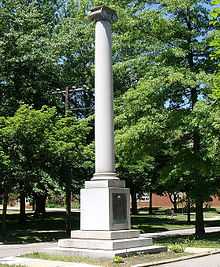Charles Vernon Gridley
| Charles Vernon Gridley | |
|---|---|
.jpg) | |
| Born |
November 24, 1844 Logansport, Indiana |
| Died |
June 5, 1898 (aged 53) Kobe, Japan |
| Buried at | Lakeside Cemetery, Erie, Pennsylvania |
| Allegiance |
|
| Service/branch | United States Navy |
| Years of service | 1860—1898 |
| Rank |
|
| Commands held | USS Olympia |
| Battles/wars |
Spanish-American War |
Charles Vernon Gridley (24 November 1844 – 5 June 1898) was an officer in the United States Navy during the American Civil War and the Spanish-American War.
Early life
Gridley was directly descended from Thomas Gridley (1612–1653), who emigrated from England to the New England area in 1633. Gridley was born in Logansport, Indiana on 24 November 1844.[1]
Naval career
After attending Hillsdale College,[2] Gridley was appointed to the United States Naval Academy in 1860.[1] Reporting for duty with his class in September 1863, Gridley joined the sloop-of-war Oneida with the West Gulf Blockading Squadron and distinguished himself with David Farragut at the Battle of Mobile Bay on 5 August 1864.[1]
Gridley was promoted to lieutenant in 1867 and lieutenant commander on March 12, 1868.[1] From 1871 to 1875, Gridley was stationed on the only United States Navy ship based on the Great Lakes at the time, the Michigan, at Erie, Pennsylvania. While stationed in Erie, he married the daughter of Judge John P. Vincent and had three children.[3] Gridley's wife was also a cousin of the late Civil War Hero, Brigadier General Strong Vincent. Gridley was promoted to commander in 1882. Gridley also served a tour as instructor at the Naval Academy and another with the Cruiser Training Squadron.
Gridley was promoted to captain in March 1897 and took command of Olympia, Admiral George Dewey's famous flagship on June 10, 1897 in Yokohama, Japan. During the Battle of Manila Bay on 1 May 1898, Dewey gave his famous command, "You may fire when you are ready, Gridley," immortalizing the captain.[1]
After the destruction of the Spanish fleet and the capture of Manila, Gridley was obliged to leave his command because of his health, and died en route to the United States at Kobe, Japan.[1]
Gridley was a member of the Empire State Society of the Sons of the American Revolution.
Legacy

Four ships in the United States Navy have been named for him.[4]
A monument to Gridley was erected in Erie and placed in the center of a city park, which was named Gridley Park. The engraved plaque affixed to the monument is made of a metal panel retrieved from the Maine.
A seashell is depicted on the coat-of-arms of Gridley's original alma mater, Hillsdale College, in honor of his heroism at the Battle of Manila Bay.[5]
See also
References
- ↑ 1.0 1.1 1.2 1.3 1.4 1.5 "USS Gridley". Dictionary of American Naval Fighting Ships. Navy Department, Naval History & Heritage Command. Retrieved 9 August 2013.
- ↑ Gridley, Gordon (2012). "Charles Vernon Gridley". gordongridley.us. Retrieved 9 August 2013.
- ↑ McSherry, Patrick (2011). "Capt. Charles V. "Steve" Gridley (1844-1898)". Spanish-American War Centennial site. Retrieved 9 August 2013.
- ↑ "Named for Captain Charles Vernon Gridley". United States Navy. 2013. Retrieved 9 August 2013.
- ↑ "Coat of Arms". Hillsdale College. 2013. Retrieved 9 August 2013.
- This article incorporates text from the public domain Dictionary of American Naval Fighting Ships. The entry can be found here.
External links
- Harris, Richard (February 1998). "U.S. Navy Captain Charles Gridley and the Battle of Manila Bay". American History.
- "Guide to the Gridley Collection". Independence Seaport Museum.
- Charles Vernon Gridley at Find a Grave
|